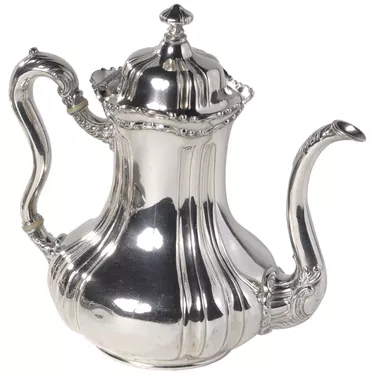
Silver has been used for centuries to fashion a wide range of items, from flatware to tea pots, from coins to objects of fine art. Many items are made of sterling silver, which is 92.5 percent silver. However, it is also possible and even likely that larger items may be silver plated.
There is a significant difference in the value of sterling silver and silver plate, and there are ways to tell which is which.
Video of the Day
Video of the Day
Step 1
Find the markings. Silver has a tendency to blacken when the layers of silver are exposed to light. This property was responsible for silver's use in the photographic industry for over 150 years. If you have a silver item that is oxidized enough to turn black, rub the back or bottom of your piece with a soft dry cotton cloth to find any markings. Start in the center and work around the outside edges until you find the markings. Once you find them, polish your silver with your dry cotton cloth until you can read the symbols and letters.
Step 2
Sterling silver is generally marked "STERLING" on the back or bottom of silver items. These sterling silver items are also likely to have a maker's name, logo, or hallmark to identify the manufacturer. Sometimes silver is marked with the decimal value for the percentage of silver, with sterling silver bearing a ".925" mark.
Step 3
SMost modern silver plated items are manufactured by using an electroplating process to cover items made of base metals, such as copper, brass, nickel silver and Britannia metal with one of more layers of silver. Another silver plating process was Sheffield plate, where thin sheets of silver were fused to the base metal to make flatware and other eating utensils.
Items made of silver plate will usually be marked with the maker's name as well as an indication of the material the item was made from. These could be "silver plate" EPNS (Electroplated Nickle Silver), E.P., EPBM (Electroplated Britannia Metal), EPC (Electroplated Copper), EPWM (Electroplate on White Metal). Generally any item marked with an EP in the initials should be considered electroplated. Other brand or generic names for plated silver include, but are not limited to: argentum, Austrian silver, German silver, new silver, Nevada silver, Sonora silver, spur silver and Venetian silver.
Step 4
Another type of silver is "coin silver", which is usually 90 percent silver and, as in the case of U.S. coins, not generally indicated on the coin. All you need to know about U.S. silver coins is that prior to and including 1964, all U.S. silver dollars, halves, quarters and dimes were made of 90 percent silver.
Tip
Large coffee-table sized books have been written about silver markings and hallmarks. Sometimes it is necessary to research unknown markings on your silver and if you add the word "silver" to the markings in question on a Google search, you should be able to find out about your item in a short time.
Things You'll Need
Jeweler's loop or magnifying glass
Soft cotton cloth